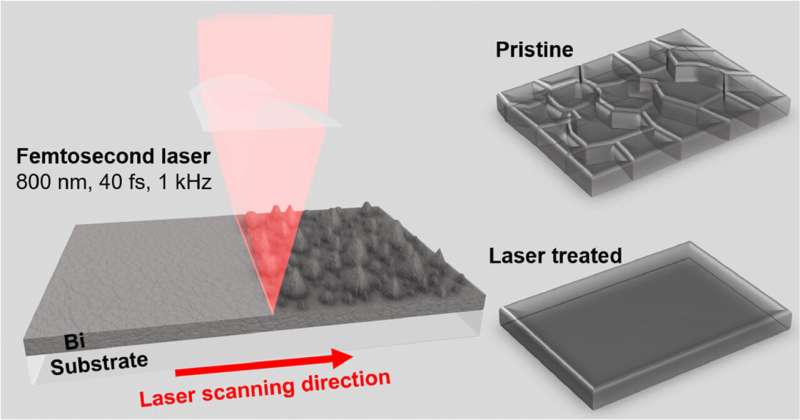This article has been reviewed according to Science X's editorial process and policies. Editors have highlighted the following attributes while ensuring the content's credibility:
fact-checked
peer-reviewed publication
trusted source
proofread
Femtosecond laser improves bismuth film quality for ultra-broadband photodetection

The researchers from Changchun Institute of Optics, Fine Mechanics and Physics of the Chinese Academy of Sciences and Peking University have developed a new technique for upgrading the quality of topological insulator bismuth films for use in ultra-broadband photodetectors. The study was published in Optics Express.
The researchers used femtosecond laser treatment to significantly improve the photoelectric conversion and carrier transportation of bismuth films, which previously limited the optoelectronic properties of the material.
Bismuth is a type of topological insulator, a class of materials that have unique properties such as gapless edge states and insulating bulk states. These properties make them promising for fabricating room-temperature, wide bandwidth, and high-performance photodetectors that can span the ultraviolet to the far-infrared and even terahertz ranges. However, bismuth films often suffer from high surface roughness and obvious grain boundaries, which can affect photoresponsivity, a key factor for topological insulator ultra-broadband photodetectors.
To overcome this challenge, the researchers used femtosecond laser treatment to modify the surface morphology and physiochemical properties of bismuth films.
Femtosecond laser is an intriguing approach that can provide non-contact high precision manufacture on various materials due to its ultra-high peak power and ultra-short time duration characteristics. By tuning the laser parameters such as pulse energy and scanning speed, the researchers were able to reduce the average surface roughness to sub-10 nm, while eliminating grain boundaries on the interface. This resulted in a remarkable improvement of carrier transportation and photoelectric conversion.
The researchers then fabricated an optoelectronic device on a large surface area of the efficiently treated bismuth film with cylindrical focusing conditions. They measured the photoresponsivity of the device under different wavelengths of light ranging from visible to mid-infrared (MIR), and found that compared with the pristine sample, the laser-treated bismuth film exhibited a two-fold increase of photoresponsivity within an ultra-broad spectrum range, even at room temperature.
The researchers suggest that this method can be further used for improving the quality of other topological insulators, which could promote their application in the field of ultra-broadband photoelectric detection. They also hope that their work can inspire more studies on femtosecond laser processing for modulating topological quantum materials.
More information: Yucai Lin et al, Femtosecond laser upgrading the quality of bismuth films to enhance ultra-broadband photodetection, Optics Express (2023). DOI: 10.1364/OE.482018
Journal information: Optics Express
Provided by Chinese Academy of Sciences





















